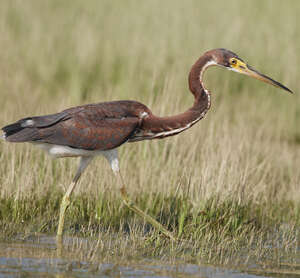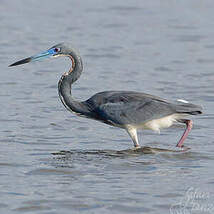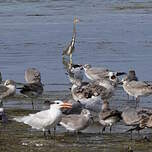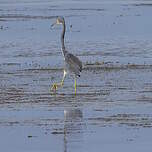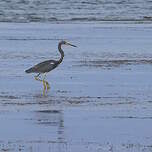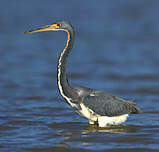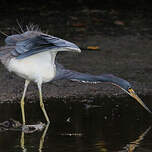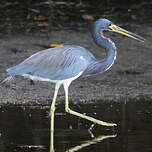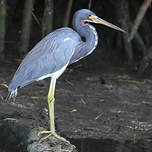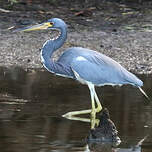Tricolored Heron
Egretta tricolor - Aigrette tricolore
Identification
The Tricolored Heron has a head, back, and wings colored slate-blue while its belly, flanks, and underwings are white - differentiating it from the Blue Heron, which is entirely slate-blue. The mantle, neck, and chest feathers may be longer, finer, and grayer during the breeding season. Its long, yellow bill is tipped with black, and a stripe of white runs down its neck from the throat to belly. The male and female are similar-looking, though the white back feathers during winter may be absent. The Tricolored Heron is a medium-sized bird with a long, slender neck, and short, strong, yellow-green legs during winter and light pink during breeding season - its beak also changing color to become a bright blue. The immature has its underwings and neck a brownish-reddish color, resembling a giant Green Heron, this plumage lasting for a year.
Subspecific information 2 subspecies
- Egretta tricolor tricolor (nc and ne South America)
- Egretta tricolor ruficollis (e and se USA and e, w Mexico to nw South America, West Indies)
Foreign names
- Aigrette tricolore,
- Garceta tricolor,
- garça-tricolor,
- Dreifarbenreiher,
- lagúnagém,
- Witbuikreiger,
- Airone tricolore,
- trefärgad häger,
- Prakthegre,
- volavka trojfarebná,
- volavka tříbarvá,
- Trefarvet Hejre,
- karibianhaikara,
- martinet tricolor,
- Hólmahegri,
- czapla trójbarwna,
- trejkrāsu gārnis,
- tribarvna čaplja,
- Трёхцветная цапля,
- サンショクサギ,
- 三色鹭,
- trefärgad häger,
- 三色鷺,
Voice song and call
Habitat
Behaviour character trait
The Tricolored Heron is a generally solitary migrant bird during the day, but it spends the night with its peers in mostly mixed dormitory-style roosts.
On its feeding grounds, it is highly territorial and energetically chases away any intruders, regardless of species. It hunts by stalking in shallow waters. It can be seen steadily wading through its hunting area, sometimes getting its belly wet. It may sometimes run in search of its prey. Like many species, it spends a lot of time preening and grooming its feathers.Dietfeeding habits
Reproduction nesting
The Tricolored Heron nests in colonies that can sometimes be very large. The male starts the nest perched on a tree two or three meters high.
The female then completes the work. The nest is made of branches and twigs forming a platform with a bowl lined with grass and leaves in the middle. The female lays 3 to 4 pale blue eggs in the nest at a rate of one per day. The parents take turns incubating the eggs for about three weeks. The eggs will hatch with a few days between them. The chicks will be fed by the couple for 35 days with regurgitated food. At around twenty days, the young begin to explore outside the nest, but they won't take flight until a month later.Geographic range
Threats - protection
IUCN conservation status
concern
in the Wild
threatened
evaluated
Reproduction can be compromised by cold weather, predation, or water levels that remain too high. Certain nocturnal raptors do not hesitate to attack adults. The populations of Tricolored Herons are stable and sometimes in slight increase, such as in the United States.
Sources of information
- IOC World Bird List (v14.2), Gill, F and D Donsker (Eds). 2024-04-18.
- Oiseaux de Guyane, Olivier Tostain, Jean-Luc Dujardin, Christian Erard et Jean-Marc Thiollay
- THe Herons Handbook, James Hancock et James Kushlan
- Avibase, Lepage Denis
- Portraits d'oiseaux Guyanais, Groupe d'étude et de protection des oiseaux en Guyane (GEPOG)
Other sources of interest
 Specification sheet created on
03/08/2023 by Jean-Pierre Trouillas
Specification sheet created on
03/08/2023 by Jean-Pierre TrouillasTranslation by AI Oiseaux.net
© 1996-2025 Oiseaux.net
- Accipitriformes
- Aegotheliformes
- Anseriformes
- Apodiformes
- Apterygiformes
- Bucerotiformes
- Caprimulgiformes
- Cariamiformes
- Casuariiformes
- Charadriiformes
- Ciconiiformes
- Coliiformes
- Columbiformes
- Coraciiformes
- Cuculiformes
- Eurypygiformes
- Falconiformes
- Galliformes
- Gaviiformes
- Gruiformes
- Leptosomiformes
- Mesitornithiformes
- Musophagiformes
- Nyctibiiformes
- Opisthocomiformes
- Otidiformes
- Passeriformes
- Pelecaniformes
- Phaethontiformes
- Phoenicopteriformes
- Piciformes
- Podargiformes
- Podicipediformes
- Procellariiformes
- Psittaciformes
- Pterocliformes
- Rheiformes
- Sphenisciformes
- Steatornithiformes
- Strigiformes
- Struthioniformes
- Suliformes
- Tinamiformes
- Trogoniformes




